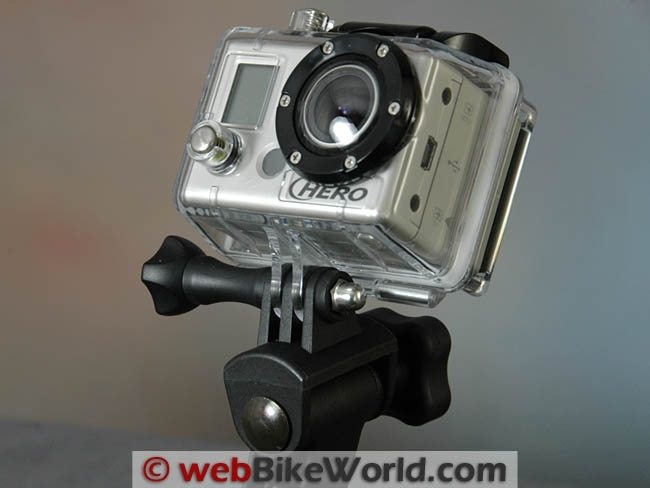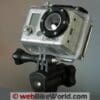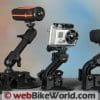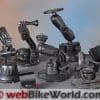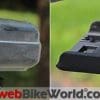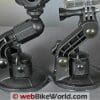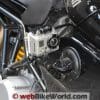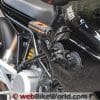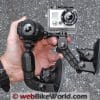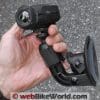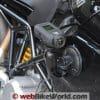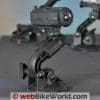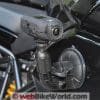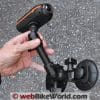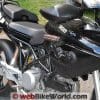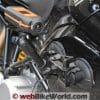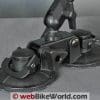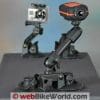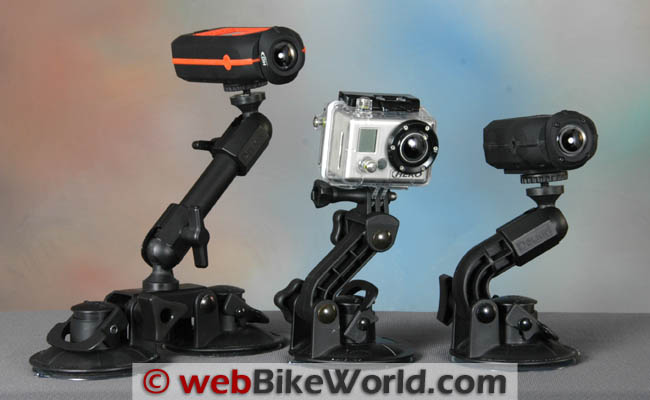The mounts that come with most motorcycle video cameras are semi-useful for mounting the camera to a helmet but not the motorcycle.
Suction cup style camera mounts are readily available and they can be used for a sturdier mounting arrangement.
These are available under a variety of brand names, including the Delkin “Fat Gecko” series shown here and mounts made by PanaVise.
The PanaVise mount is also available with the special GoPro forked adapter for holding the GoPro HD (review) and other GoPro cameras.
Suction cup mounts aren’t the perfect solution though; there are some tricks and tips for using them that are outlined in this review.
We’ve been ranting about motorcycle camera mounts since the first video camera review was posted on webBikeWorld.com back in 2008 (VholdR Video Camera review).
The situation is this: most (or all) of the motorcycle video cameras come with a small selection of plastic clips that are supposed to be used for mounting the camera on a helmet or on the motorcycle itself.
But we haven’t found any of these clips to be all that useful.
The manufacturers seem to spend a lot of time thinking about the camera and very little time thinking about how to mount it on the bike.
And the “best” motorcycle video camera around will yield sub-optimal results if it isn’t mounted properly.
The typical clip-style mount that is supplied with the camera usually has a strip of double-sided tape on the back.
So if you happen to own a helmet with enough flat surface area — and if you happen to know exactly where to place the camera to point in a direction that will get you some decent video, then you’re in luck.
Otherwise…well, you’re…out of luck.
And those adapters are even less useful for mounting the camera on the bike.
Most motorcycles also have limited surface area for mounting a camera and the complex curves and shapes mean that the camera lens must have a certain amount of standoff from the surface of the fuel tank, fairing or wherever.
Here’s another related issue: The lenses on these motorcycle video cameras usually have a very wide field of view.
Some of them are nearly equivalent to “people vision”; up to 170 degrees wide on one of our favorites, the Drift HD170 video camera (review) and the new Drift HD 1080p we’re currently evaluating (a prototype for Drift Innovation).
This means that the camera must also be mounted with the lens at a great enough distance from the surface of the motorcycle to get a clear view of the road ahead, or risk having half the frame filled with a boring and fly-specked gas tank.
Currently, the solution with the best (or should I say most efficient) performance-to-cost ratio (i.e., “value”) is the good ol’ suction cup mount, originally designed for still cameras.
I’d guess these are made by one or two factories somewhere and pumped out under a variety of brand names, because no matter who sells them, they seem to be nearly identical, with only a different brand name stamped in the plastic.
The Suction Cup Camera Mount
The suction cup mount has become somewhat standardized in shape, form and function and they’re readily available just about everywhere cameras are sold.
Delkin, a well-known manufacturer of all sorts of electronic and computer accessories, also makes one of most popular brands of suction cup camera mounts around, the Delkin Fat Gecko. It’s available in single and double cup styles, as shown in our photos.
The Fat Gecko mounts have a U.S. Patent number stamped on them, so it’s possible that all of these type of mounts are made by Delkin and re-branded, I’m not sure.
Another line of camera mounts that look strangely similar to the Delkin mounts but are also fairly commonplace are the Panavise camera mounts.
The company also makes a special suction cup mount with the “forked” head required to mount the GoPro family of video cameras, which have a different form factor than, for example, the Drift cameras or the VholdR Contour HD (review).
GoPro sells that special mount, made by PanaVise for them, and they’ve been pretty good at controlling its distribution, because it’s difficult to buy one from anywhere but the GoPro website.
Fortunately, they’re pretty good about the pricing and the mount isn’t marked up much at $29.99, about what the other mounts cost.
Suction Cups and Mounting Factors
Let’s start at the bottom first, because that’s the easiest part to describe and the suction cups work very well.
Basically, the suction cups on these mounts are all the same, and I’ve seen and used many other different brands over the years (I was a professional photographer).
The suction cup material is a soft synthetic rubber-like material.
There’s a button on the top side and you put the clean suction cup on a clean and dry non-porous surface, then press down hard on the button.
This pushes the center of the cup down on to the mounting surface and pushes out the air.
You then flip up the bail or handle, which pulls back on the suction cup and creates a vacuum to provide the suction.
If these are mounted on a nice, clean, non-porous flat (or mostly flat) surface, like the side of a fuel tank, fairing, etc., they provide excellent grip.
I don’t know how much weight they’ll hold but I bet you’d dent the fuel tank before you pulled this sucker off.
So the suction cup base isn’t the problem; it’s the upper part of the mount that can cause issues.
The ideal mounting situation is to have the camera mounted as close to the suction cup and as low as possible.
That’s because generally speaking, as the camera is placed farther away from the suction cup or base, the distance acts like a pendulum and quickly increases the chances of vibration or bouncing.
But remember — with that wide field of view, the camera needs to have some standoff from the surface, otherwise it can capture too much of that gas tank in the frame.
A super-solid mounting arrangement is especially important on a motorcycle, which has a lot of movement and vibration anyway, or fairing pieces that may be a bit flexible. But even solid mounting surfaces aren’t a guarantee of shake-free video.
For example, the other day we were comparing the new Drift HD 1080p camera with the Drift HD170 and the GoPro HD.
We used the three suction cup mounts shown in the photos and mounted them on the front of a pickup truck, which is a very solid and vibration free surface compared to a motorcycle. But even then, we noticed vibration and shudder in the resulting video.
The Delkin Fat Gecko single cup and the PanaVise GoPro mount have short arms to mount the camera, so the movement and vibrations can be relatively controlled (as long as the camera is light weight).
But another factor to consider is the type and number of joints in the arm and the mount.
Every joint is a potential weak area that can create more vibration or movement, so the friction nuts/knobs must always be tightened and the key is to try and place the mount in such a way that minimizes the amount of reach.
The problem with all three of these mounts in this review is that the bail or handle has to be moved up, rather than down, to pull on the suction cup.
This interferes with the downward travel of the arm and you lose about 15% of the travel.
Due to the thickness of the cameras, you can’t always get the camera pointed in the optimal direction, even if you found a good, flat surface to hold the suction cup. It then becomes a matter of compromise.
The upwards-moving bail problem is is illustrated in the quick 2-minute video.
Unfortunately, all of the manufacturers must source their suction cups from the same supplier, because I haven’t found a suction cup mount that works differently.
We bought the Delkin Fat Gecko double suction cup mount because we figured “If one is good, two must be better.” Nope.
Not only is this mount too wide to use on many motorcycles, the long arm, which ironically provides almost unlimited degrees of freedom with regards to travel, is a prime source of vibration and camera movement.
We’ve tried this mount with all sorts of cameras, motorcycle video cameras and pro cameras and in almost every instance, it vibrates so much as to be useless.
Part of the problem is that to provide the wide range of movement, the arms use ball joints, which have a limited amount of surface area for holding, no matter how tight the friction knobs are.
If you own a GoPro HD or other GoPro camera, you don’t have many choices.
The PanaVise GoPro suction cup mount is nearly identical to the Delkin Fat Gecko single cup, but it has the special GoPro mount molded in to the arm as part of the unit.
GoPro also makes a 1/4-20 standard tripod mount adapter with the forked bottom.
(Note: The Panavise 809 Camera Suction Cup Mount is also available with the standard 1/4-20 screw mount; it’s called a “window mount”.)
Which leads me to an issue that I should have addressed up front: the camera must have the standard 1/4-20 tripod mount for any of these suction cup mounts to work (other than the special GoPro style).
Not every video camera has a 1/4-20 tripod mount, unfortunately, but this should definitely be a standard feature on every camera and video camera.
And the mount should be made of metal, because you need to really tighten it up to try and avoid any vibration and plastic threads can deform under the load.
The Drift family of cameras has a metal mount on the bottom, one of the reasons we like them.
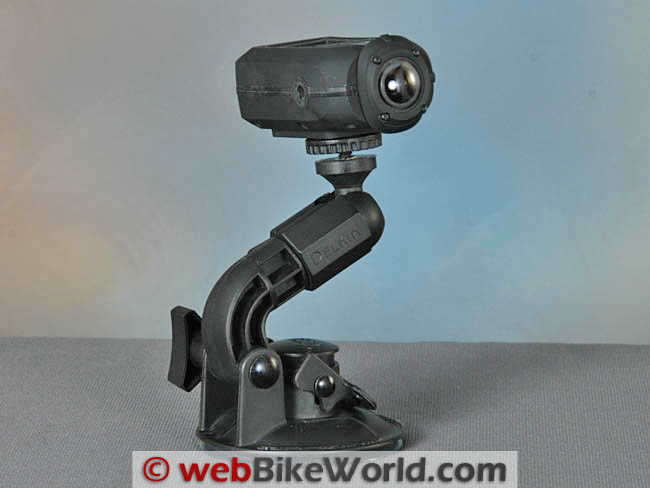
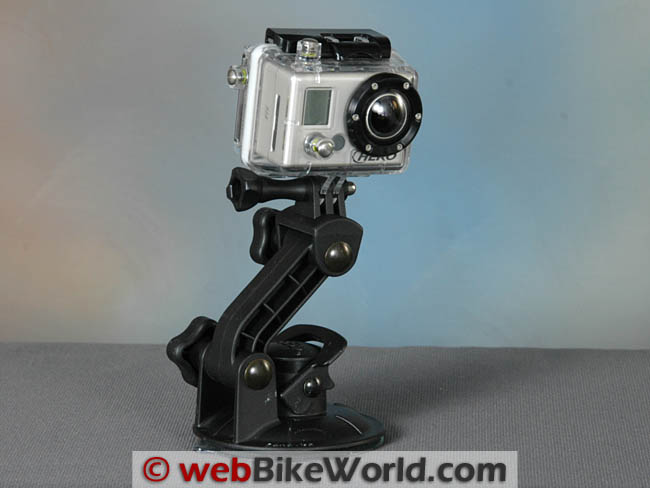
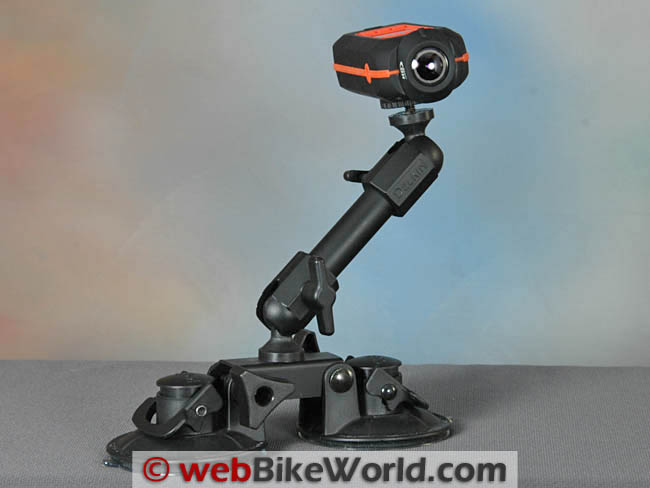
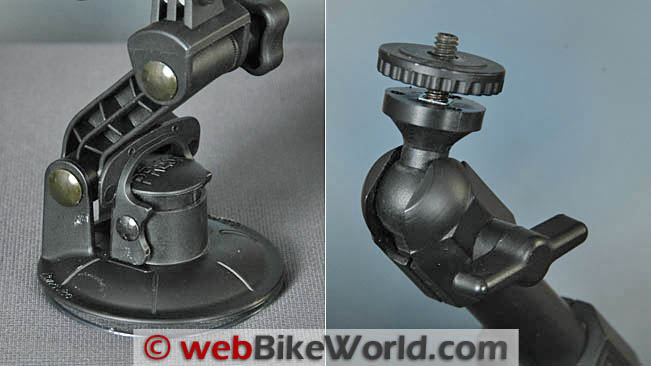
And More Mounting Tips…
I’ve probably gone on way too long about what should be a simple product, but as long as I’m on a roll…
First, of course, is finding a good location for mounting the camera on the bike.
This is where it really, really comes in handy to have a camera with a live view, so you can be sure it’s pointing in the right direction before you run that world’s record lap time.
It’s also one of the reasons we originally liked the Drift HD170 so much; it was the first with a live view.
Next, make sure that the suction cup really is going to hold — and you might want to put a couple of strips of duct tape over it just to be on the safe side. Then, make sure all the friction knobs are tight.
Don’t overdo it, but you may have to check each nut two or three times, because if you tighten one, sometimes the other becomes slightly loose.
Also, remember the friction nut on the tip of the mount — the one that pushes up against the bottom of the camera to hold it.
I can’t tell you how often I’ve made everything tight on the mount but forgot to make sure the camera itself was tightly secured.
After I check, re-check and triple-check everything, I take off and stop about a klick or two into the ride, just to check everything once more. At that point, I turn on the camera.
Make sure the camera is on — again, I’ve lost track of how many times I thought the camera was on when it wasn’t.
The beeps the cameras make can’t be heard over the engine noise, when you’re wearing a helmet and ear plugs. So you have to look at the live view or the indicator to make sure the thing is on and running and the seconds are counting off.
Even then, I guarantee sometimes you will miss taking that great video…
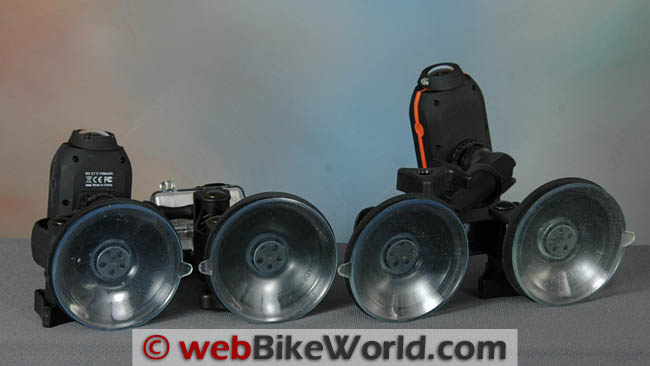
Conclusion
Currently, the suction cup type mounts are about the best compromise out there for mounting a video camera on a motorcycle.
I know there are other types of mounts and I’ve tried them all (more or less).
Handlebar mounts are usually too wobbly and transmit too much vibration.
And they’re not always easy to mount. And if your bike has a windscreen or fairing, they don’t always work.
There are expensive metal mounts that screw into the fuel tank cap ring. I tried one and it suffered from vibration problems and it didn’t lift the camera up high enough to see over the bar.
There’s always the helmet mount and, believe it or not, one of the best and cheapest methods is to use a clip mount on a pair of goggles, but you’ll need a motocross or open-face helmet for that.
I would be very interested to hear from webBikeWorld readers on how they mount their video cameras on the motorcycle itself, or other options for mounting.
In the meantime, the suction cup mounts are, well, they’re OK.
They’re not perfect by any means, but they’re cheap enough and they do a decent job. Hopefully, some manufacturer will come up with a smaller, lighter and sturdier type of mount.
And, the cameras have to get way smaller than they are. Lighter and smaller, with better quality video. Is that too much to ask?!
More webBikeWorld:
▪ Video Action Camera Reviews
▪ Intercom and Radio Reviews
| wBW Review: Motorcycle Video Camera Mounts | |
|---|---|
| Manufacturer: Delkin and PanaVise | List Price: $28.00 to $35.00 (Here). |
| Colors: Black. | Made In: China |
| Review Date: August 2011 | |
Owner Comments and Feedback
See details on submitting comments.
From “K.M.” (August 2011): “My favorite motorcycle mount for the GoPro is the chest mount. It provides a very stable platform, no vibration, and good field of view to the front of the motorcycle. Here is a fairly recent (YouTube) video shot with the GoPro camera chest mount.”
From “M.M.” (August 2011): “I use a Manfrotto Super Clamp, and a ball head. I attach this to my (motorcycle) frame slider, and it’ll hold a pro-grade DSLR and lens.
The clamp and platform run about $45, and the ball head can be as cheap or expensive as you like, but from $50 up is realistic.
The problem I’ve found with extension arms is what you noted in your review – vibration gets really bad as you extend out. For really serious work, I think the way to go would be to triangulate the mount. You can see examples here (Filmtools.com).
From “R.L.” (August 2011): “Greetings from the Netherlands! I noticed your YouTube recording on your short review of the Camera Mounts and subsequently the review on your website.
I can say I’m quite experienced with Action cameras and motorcycling.
I own one VHoldR (nowadays called Contour) HD 1080P (review); two GoPro Hero HD (review)(and two LCD BacPac (review) and two Battery BacPac); one VIO POV HD and the various mounts, expansions and some home-made stuff.
Back to the topic at hand: I have all the mentioned suction-cup mounts you mentioned and more.
The worst to mount is the Contour version, you will need almost to slam (instead of slide) the camera into their bracket. Tolerances are very, very tight. Holding-power: OK.
The fair one is the one for the GoPro Hero HD; It has difficulty most of the time to hold longer, or even to hold, full stop. I sometimes have great difficulty to get to hold.
The best experiences I have so far is with the Fat Gecko; It really holds, even at high speeds.
Never had any issues with them. And I have several Fat Gecko’s, including the double suction-cup version. PS: You can actually disassemble the arm of the Fat Gecko’s and mount shorter versions of the arms, if so needed. (Fat Gecko Extension kits).
What I also noticed with the Fat Gecko is the fact that it seems to dampen the vibrations of the motorcycle to a certain extent. I really like the Fat Gecko’s, they have not let me down so far.
My tips of the day when using suction-cup mounts:
- Do *not* leave a suction-cup mount on for days, but remove it after use.
- Choose a suction-cup mount that has good (360 degrees preferred) rotating-capability, because it is easier to reposition the camera then the suction-cup mount!
- Follow the instructions for mounting always very carefully, such as cleaning the surface, the suction-cup it self and so on.
- It is highly recommended to use a nylon catch-wire (fish-wire?) on the camera itself and a fixed point on your motorcycle. In case the suction-cup fails and your camera bounces all over the highway!
- When using suction-cup mounts pay special attention to temperatures; do not mount when it is too cold, as the suction-cup may become too stiff and not hold on strong enough.
- For your viewing-pleasure it is recommended to use the suction-cup mount on the side-fairing as much to the front, and avoid too much (static) motorcycle-contours in your frame. It is recommended to leave a small part of your motorcycle (edge?) in the frame, so the viewers can get a better perspective of speed and depth. Recording into the “open world” tend to be disorientating at times.
- Always make trial-recordings to find the optimum position for your suction-cup mount. Flat surfaces are good places to mount a suction-cup. Once you found a good location, consider marking that spot by putting painters-tape (or something that does not leave glue behind or affect the painting on your fairing) next to the suction-cup’s edge, on 3 or 4 sides.
PS: And (here is) my YouTube channel: In the PIP and POV recordings I have been using the GoPro HD Hero, and my last recording is with the VIO POV HD (with the VIO POV HD I have had great difficulty figuring out how to use their mounting options, their documentation leaves a lot to be desired. Great camera, though!)”
Editor’s Note: Great tips, thanks!


